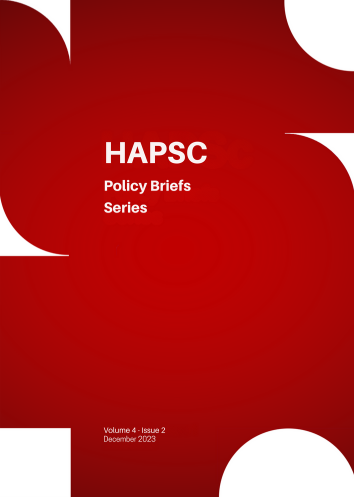Social Policy: Religious Neutrality in a Multicultural World

Published:
Dec 31, 2023
Keywords:
European Union Religious neutrality Court of Justice Discrimination Multicultural World Human Rights Legitimate Aim
Abstract
Religious rights are an especially important aspect of social policy. This policy brief aims to inform the audience about the perception of some European countries about religious neutrality in multicultural societies. Is there a sharp vision that must be followed by all countries? Can the decision of the Court of Justice have absolute implementation in all countries? What can Greece do to establish its role as a multicultural country while avoiding the danger of social unrest?
Article Details
- How to Cite
-
Gkika, I. (2023). Social Policy: Religious Neutrality in a Multicultural World. HAPSc Policy Briefs Series, 4(2), 164–170. https://doi.org/10.12681/hapscpbs.36695
- Section
- Articles

This work is licensed under a Creative Commons Attribution 4.0 International License.
Authors retain copyright and grant the journal right of first publication with the work simultaneously licensed under a Creative Commons Attribution License that allows others to share the work with an acknowledgement of the work's authorship and initial publication in this journal.Downloads
Download data is not yet available.
References
Aziz, S. (2022). France is on a dangerous collision course with its Muslim population. United Kingdom: CNN.
Cranmer, F. "Hijabs in the CJEU again: SCRL" in Law & Religion UK, 14 022, Available at https://lawandreligionuk.com/2022/10/14/hijabs-in-the-cjeu-again-scrl/ (Accessed: 06/11/2023).
Department, S. R. (2021, February). statista.com Available at: https://www.statista.com/statistics/996244/feeling-belong-religion-france/ (Accessed: 06/11/2023).
European Union: Council of the European Union, Charter of Fundamental Rights of the European Union (2007/C 303/01), 14 December 2007, C 303/1. Available at: https://www.refworld.org/docid/50ed4f582.html (Accessed: 06/11/2023).
Helmut Müller GmbH v Bundesanstalt für Immobilienaufgaben, C-451/08 (CJEU January 1, 2010).
Hunter-Henin, M. (2022). Religious Neutrality at Europe’s Highest Courts: Shifting Strategies Available at: https://academic.oup.com/ojlr/article/11/1/23/6811795#395491044 (Accessed: 06/11/2023).
Ioannis Yagkinis. (2022). European Court: Legal prohibition of the headscarf.
Kastoryano, P. R. (2010). europa.eu. Available at https://ec.europa.eu/migrant-integration/library-document/tolerance-and-cultural-diversity-discourses-france_en (Accessed: 06/11/2023).
L.F. v SCRL, C 344/20 (CJEU October 13, 2022).
Manitakis, A. (2019, February 28). The religious neutrality of the state in a pluralistic (and multicultural) society. Aristovoulos Manesis Group.
McEvoy, O. (2023, February 28). Perceptions on religious identity and being German in 2018. Available at: statista.com. (Accessed: 06/11/2023).
Mulder, J. (2022). Religious neutrality policies at the workplace: Tangling the concept of direct and indirect religious discrimination. WABE and Müller. Common Market Law Review, 59(5), 1501-1522.
Union, D. t. (2021). curia.europa.eu. Available at: https://curia.europa.eu/jcms/upload/docs/application/pdf/2021-07/cp210128el.pdf (Accessed: 06/11/2023).
Union, S. t. (2000). DIRECTIVE 2000/78/EC OF THE COUNCIL. Official Journal of the European Communities.
Vickers, L. (2017, March 15). Direct Discrimination and Indirect Discrimination: Headscarves and the CJEU. Oxford Human Rights Hub.
Vickers, L. (2021, July 29). Religious Discrimination and Headscarves – Take Two. Oxford Human Rights Hub.
Youthreporter (2021). Is Germany a multicultural or intercultural country? Available at https://www.youthreporter.eu/de/beitrag/is-germany-a-multicultural-or-intercultural-country.17236/#.Y-piRnZBy5e (Accessed: 06/11/2023).


